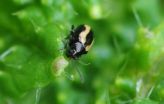(Press-News.org) Almost all herbivorous insects are specialized to feed on specific host plants and have adapted to their chemical defenses. Flea beetles are important pests of cabbage and other cruciferous plants, such as mustard, horseradish and rapeseed. These plants use a sophisticated defense system, known as the mustard oil bomb, to get rid of their enemies : If plant tissues are wounded, glucosinolates and an enzyme known as myrosinase come into contact, and, as a result, toxic metabolites are formed which deter most insects. This defensive mechanism, however, has no negative effect on flea beetles, according to scientists from the Max Planck Institute for Chemical Ecology in Jena, Germany. Flea beetles are even able to sequester glucosinolates without the mustard oil bomb being set off by the plant's enzyme. Moreover, the insects use their own myrosinase and can utilize the plants' defensive chemicals for their own purposes. The beetles' mustard oil bomb is likely to fend off predators. (Proceedings of the National Academy of Sciences of the USA, May 2014, doi: 10.1073/pnas.1321781111)
Plants defend themselves against herbivores by employing a large arsenal of chemical substances, so-called secondary metabolites. In return, many insects have counter-adapted to plant defenses and can feed on their host plants without any problems. The "arms race" between plants and insects is behind the amazing variety of different species; variations emerged in the course of co-evolution of those two major groups of organisms. Some insects − leaf beetles or tobacco hornworms, for example − even utilize plant metabolites for their own defenses.
Franziska Beran, head of the research group "Sequestration and Detoxification in Insects" at the Max Planck Institute for Chemical Ecology in Jena, Germany, and her colleagues study flea beetles (Phyllotreta). The small pest insects, whose name refers to their impressive jumping ability, prefer to feed on the young leaves of all cabbage species and their method of feeding causes a characteristic pitting damage. They are despised by gardeners and farmers. Before she started working on her PhD project at the Berlin Humboldt University, the young scientist completed an internship at the AVRDC-The World Vegetable Center in Taiwan, where she first learned about the devastating damage this beetle species causes on cabbage cultures in Southeast Asia. Her PhD thesis focused on how the insects aggregate and she asked if they use pheromones and plant odors as olfactory cues. She found out that male flea beetles emit a pheromone that attracts conspecifics; however, the attraction occurs only in conjunction with plant volatiles. At the core of her analyses were the degradation products of glucosinolates, plant metabolites that are responsible for the all-too-familiar smell of cabbage.
For their current project, the scientists compared glucosinolates in the host plants to the volatile degradation products that are formed when beetles feed on the plants, damaging plant tissues. The plant defense mechanism − called the mustard oil bomb because the degradation products that are formed are toxic − consists of two components: the glucosinolate and the activating enzyme myrosinase. Usually, the glucosinolate-myrosinase system is a highly efficient defense strategy cabbage plants deploy to deter herbivores. However, it does not repel the flea beetles, which readily infest the plants. Analyses showed that volatile degradation products were present when plants were infested with flea beetles, but the substances were not emitted by the plants. It appeared that the flea beetles themselves were emitting the volatile glucosinolate metabolites. Further experiments revealed that flea beetles can take up and store an amount of glucosinolates equivalent to almost 2% of their own body weight. Although cabbage plants contain a large variety of different glucosinolates, the beetles sequester only some of them. Franziska Beran made a surprising conclusion: "The beetles have evolved their own activating myrosinase which specifically hydrolyzes the glucosinolates which they have sequestered from the plants."
The research results indicate that flea beetles not only survive the cabbage plants' mustard oil bomb unscathed, the insects even utilize selectively sequestered glucosinolates for their own purposes. Aphids are known to deploy a similar strategy. However, unlike aphids, which suck the phloem by tapping individual plant cells, flea beetles are chewing insects that wound leaf tissues. Such wounding should activate the mustard oil bomb but does not. Why this is the case and why flea beetles are able to sequester intact glucosinolates is still a mystery. Somehow the insects manage to inactivate the plant's myrosinase. The researchers want to find out where the beetles store the glucosinolates, how they control their own mustard oil bomb, and why they can hydrolyze glucosinolates without being poisoned by the resulting degradation products. Particularly interesting is the question: Why do the insects sequester glucosinolates and how do they control glucosinolate hydrolysis with their own enzyme? "On the one hand, either the glucosinolates or their degradation products may play an important role in the beetles' communication with conspecifics. On the other hand, they may have a specific function in the insects' defense against their own enemies," Franziska Beran hypothesizes. She also wonders about the beetle larvae which live underground and feed on roots. They are exposed to many predators and pathogens and a good chemical defense is definitely advantageous.
Behavioral studies will now also be used in order to elucidate the ecological function of glucosinolate sequestration in flea beetles. Better understanding of insect adaptation to plant chemical defenses will likely contribute to better control of mass occurrences of agricultural pests that are a major problem worldwide. [AO/FB]
INFORMATION:
Original publication:
Beran, F., Pauchet, Y., Kunert, G., Reichelt, M., Wielsch, N., Vogel, H., Reinecke, A., Svatoš, A., Mewis, I., Schmid, D., Ramasamy, S., Ulrichs, C., Hansson, B. S., Gershenzon, J., Heckel, D. G. (2014). Phyllotreta striolata flea beetles utilize host plant defense compounds to create their own glucosinolate-myrosinase system. Proceedings of the National Academy of Sciences of the United States of America. doi: 10.1073/pnas.1321781111
http://www.pnas.org/cgi/doi/10.1073/pnas.1321781111
Further information:
Dr. Franziska Beran, Max Planck Institute for Chemical Ecology, Hans-Knöll-Straße 8, 07745 Jena. Tel. +49 3641 57-1553, E-Mail fberan@ice.mpg.de
Contact and picture requests:
Angela Overmeyer M.A., Max Planck Institute for Chemical Ecology, Hans-Knöll-Str. 8, 07743 Jena, +49 3641 57-2110, overmeyer@ice.mpg.de
Download of high resolution images via http://www.ice.mpg.de/ext/735.html
Beetles that taste like mustard
Flea beetles outwit their host plant's mustard oil bomb and use it for their own purposes
2014-05-08
ELSE PRESS RELEASES FROM THIS DATE:
Pesticides: Research provides new insights into their effects on shrimps and snails
2014-05-08
Ground breaking research by an international team of scientists has resulted in greater understanding of the effects of pesticides on aquatic invertebrates such as shrimps and snails.
Research published in the journal Environmental Science & Technology by a team of scientists from the UK, Switzerland and Finland provides an important new approach for systematically measuring and modelling the sensitivity of aquatic invertebrates to various pesticides.
Aquatic invertebrate species are abundant in European freshwaters and play an important role in the decomposition of organic ...
Luminescent nanocrystal tags enable rapid detection of multiple pathogens in a single test
2014-05-08
WEST LAFAYETTE, Ind. — A research team using tunable luminescent nanocrystals as tags to advance medical and security imaging have successfully applied them to high-speed scanning technology and detected multiple viruses within minutes.
The research, led by Macquarie University in Sydney, Australia and Purdue University, builds on the team's earlier success in developing a way to control the length of time light from a luminescent nanocrystal lingers, which introduced the dimension of time in addition to color and brightness in optical detection technology.
Detection ...
Cedars-Sinai study: Common drug restores blood flow in deadly form of muscular dystrophy
2014-05-08
LOS ANGELES (May 7, 2014) – Cedars-Sinai Heart Institute researchers have found that a commonly prescribed drug restores blood flow to oxygen-starved muscles of boys with Duchenne muscular dystrophy, a genetic muscle-wasting disease that rarely is seen in girls but affects one in 3,500 male babies, profoundly shortening life expectancy. It is the most common fatal disease that affects children.
Muscle weakness begins in early childhood, often causing deformity of the arms, legs and spine. Heart and respiratory muscles often begin to fail before children reach early teen ...
New study sheds light on survivors of the Black Death
2014-05-08
A new study suggests that people who survived the medieval mass-killing plague known as the Black Death lived significantly longer and were healthier than people who lived before the epidemic struck in 1347.
Caused by the bacteria Yersinia pestis, the Black Death wiped out 30 percent of Europeans and nearly half of Londoners during its initial four-year wave from 1347 – 1351.
Released Wednesday (May 7) in the journal PLOS ONE, the study by University of South Carolina anthropologist Sharon DeWitte provides the first look at how the plague, called bubonic plague today, ...
New care approach eases depression among women
2014-05-08
Women who received collaborative care for depression at an obstetrics and gynecology clinic showed fewer symptoms after treatment than women receiving usual depression care in the same setting, recent University of Washington research found.
The collaborative approach comprises counseling and greater patient engagement than is typical of mental health care at specialty clinics. It involves psychiatrists, clinicians, specialists and depression care managers. The team meets weekly to review patient progress and provide treatment recommendations. The care manager follows ...
First-ever study describes deep-sea animal communities around a sunken shipping container
2014-05-08
MOSS LANDING, CA — Thousands of shipping containers are lost from cargo vessels each year. Many of these containers eventually sink to the deep seafloor. In 2004, scientists at the Monterey Bay Aquarium Research Institute (MBARI) discovered a lost shipping container almost 1,300 meters (4,200 feet) below the surface of the Monterey Bay National Marine Sanctuary. In the first-ever survey of its kind, researchers from MBARI and the sanctuary recently described how deep-sea animal communities on and around the container differed from those in surrounding areas.
In February ...
Mouse study offers new clues to cognitive decline
2014-05-08
New research suggests that certain types of brain cells may be "picky eaters," seeming to prefer one specific energy source over others. The finding has implications for understanding the cognitive decline seen in aging and degenerative diseases such as Alzheimer's and multiple sclerosis.
Studying mice, investigators from Washington University School of Medicine in St. Louis showed that a specific energy source called NAD is important in cells responsible for maintaining the overall structure of the brain and for performing complex cognitive functions. NAD (nicotinamide ...
Improving air quality in NYC would boost children's future earnings
2014-05-08
Reducing air pollution in New York City would result in substantial economic gains for children as a result of increasing their IQs. The study is the first to estimate the costs of IQ loss associated with exposure to air pollution, and is based on prior research on prenatal exposure to air pollutants among low-income children by Frederica Perera, PhD, lead author of the current study, and colleagues at the Columbia Center for Children's Environmental Health at the Mailman School of Public Health.
The researchers made their calculation using a hypothesized modest reduction ...
Listening to bipolar disorder: Smartphone app detects mood swings via voice analysis
2014-05-08
ANN ARBOR, Mich. — A smartphone app that monitors subtle qualities of a person's voice during everyday phone conversations shows promise for detecting early signs of mood changes in people with bipolar disorder, a University of Michigan team reports.
While the app still needs much testing before widespread use, early results from a small group of patients show its potential to monitor moods while protecting privacy.
The researchers hope the app will eventually give people with bipolar disorder and their health care teams an early warning of the changing moods that ...
Why a bacterium got its curve -- and why biologists should know
2014-05-08
Drawing from his engineering background, Princeton University researcher Alexandre Persat had a notion as to why the bacteria Caulobacter crescentus are curved — a hunch that now could lead to a new way of studying the evolution of bacteria, according to research published in the journal Nature Communications.
Commonly used in labs to study cell division, C. crescentus naturally take on a banana-like curve, but they also can undergo a mutation in which they grow to be perfectly straight. The problem was that in a laboratory there was no apparent functional difference ...
LAST 30 PRESS RELEASES:
This new understanding of T cell receptors may improve cancer immunotherapies
A new fossil face sheds light on early migrations of ancient human ancestor
A new immunotherapy approach could work for many types of cancer
A new way to diagnose deadly lung infections and save lives
40 percent of MRI signals do not correspond to actual brain activity
How brain-inspired algorithms could drive down AI energy costs
Gum disease may be linked to plaque buildup in arteries, higher risk of major CVD events
Contrails are a major driver of aviation’s climate impact
Structure of dopamine-releasing neurons relates to the type of circuits they form for smell-processing
Reducing social isolation protects the brain in later life
Keeping the heart healthy increases longevity even after cancer
Young adults commonly mix cannabis with nicotine and tobacco
Comprehensive review illuminates tau protein's dual nature in brain health, disease, and emerging psychiatric connections
Book prepares K-12 leaders for the next public health crisis
Storms in the Southern Ocean mitigates global warming
Seals on the move: Research reveals key data for offshore development and international ecology
Sports injuries sustained during your period might be more severe
World's first successful 2 Tbit/s free-space optical communication using small optical terminals mountable on satellites and HAPS
Can intimate relationships affect your heart? New study says ‘yes’
Scalable and healable gradient textiles for multi‑scenario radiative cooling via bicomponent blow spinning
Research shows informed traders never let a good climate crisis go to waste
Intelligent XGBoost framework enhances asphalt pavement skid resistance assessment
Dual-function biomaterials for postoperative osteosarcoma: Tumor suppression and bone regeneration
New framework reveals where transport emissions concentrate in Singapore
NTP-enhanced lattice oxygen activation in Ce-Co catalysts for low-temperature soot combustion
Synergistic interface engineering in Cu-Zn-Ce catalysts for efficient CO2 hydrogenation to methanol
COVID-19 leaves a lasting mark on the human brain
Scientists use ultrasound to soften and treat cancer tumors without damaging healthy tissue
Community swimming program for Black youth boosts skills, sense of belonging, study finds
Specific depressive symptoms in midlife linked to increased dementia risk
[Press-News.org] Beetles that taste like mustardFlea beetles outwit their host plant's mustard oil bomb and use it for their own purposes




